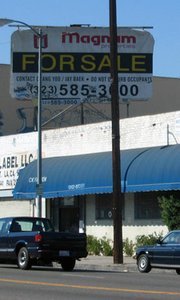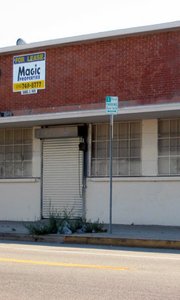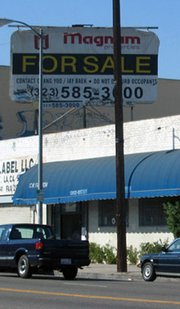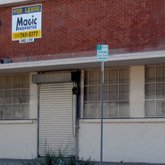Real Estate Opens Up in Former Garment Contracting Spaces
Los Angeles’ garment contractors are struggling, and they’re leaving behind a wave of unoccupied real estate in their wake.
Along Main Street south of Washington Boulevard, more than a dozen “for sale” and “for lease” signs have popped up over the past few months. Similar scenarios can be seen on Broadway and Hill streets. Having a couple per block is not unusual, but the area just south of the Los Angeles Fashion District has been hit hard by vacancies.
The area is home to dozens of garment-industry contractors, including small cut-and-sew operations, dye houses, screen-printing operations, sewing-equipment suppliers, visual-display suppliers, etc. Many of the businesses are run by Korean Americans who have felt the brunt of the economy.
“It’s very hard. Merchandise is not moving at the retail level, and it’s like a chain link from there,” explained Sam Kim of the Korean American Garment Industry Association, a trade group that represents many of the companies.
Kim said that it has been tough enough for these businesses to deal with the immigration-compliance issues along with occupational and environmental regulations.
In addition to increased workers’ compensation insurance costs, local and federal governments have placed the onus on employers to account for the legality of their workers as well as their companies. Some employers have had to revamp their accounting systems as a result. Some fines for non-compliance have increased as much as 25 percent. In addition, the Department of Immigration and Customs Enforcement has stepped up raids within California’s apparel manufacturing community.
“Some have gone out of business. Some have moved into other industries, but most are in a downsizing mode. The owners are wearing many hats right now,” Kim said.
The situation among members of the Garment Contractors’ Association is not so grim, but Joe Rodriguez, executive director of the Los Angeles–based organization, said he expects to see similar occurrences for companies he represents in the coming months.
“I thought I would be hearing of a lot of it by now, but I haven’t,” he said. “Our contractors work on a calendar year, so I suspect in January, you might see some taking action. People are very apprehensive and cautious.”
What once was a very tight real estate market in South Los Angeles is now opening up. The area in between Washington and Martin Luther King boulevards and the 110 freeway and Long Beach Avenue is desirable because it’s so close to the Fashion District and Southeast Los Angeles and the city of Vernon, which many apparel manufacturers call home.
Rents in the area have dropped down to 70 cents per square foot for small industrial space of around 5,000 to 6,000 square feet, said Daniel Park of Magic Properties, one of several brokers who work the area.
Another broker, Steven Chang of Los Angeles–based Top Properties, said his company has been forced to evict some tenants.
“Many of these [garment] contractors are in debt. People aren’t buying clothes anymore,” he said.
Craig Phillips of Lee & Co. said it took a year to find a seller for a building he represents at the corner of Washington Boulevard and Los Angeles Street.
Park estimated the current vacancy rate at about 2.5 percent, which is still fairly low. “There is still a lot of demand,” he said. He’s trying to sell a 24,000-square-foot building on Broadway for $3.4 million. Among his listings for lease is a 6,000-square-foot building at Jefferson and Main for 75 cents per square foot.
Bryan Lee of North American real estate said it’s taking a little longer to fill up vacancies. It’s averaging about three months right now, he said. Lee is looking for tenants for the Himco building, located on the 3300 block of Main Street, along with several buildings on Alameda.
Gabriel Starkman of sewingequipment maker Consew Inc. has been on Hill Street for the past three years. He said doing business in this section of Los Angeles has been a test of survival of the fittest.
“We have seen lots of competitors go out of business, but we have to be here. It’s central to [our customers],” he said.
According to CB Richard Ellis Real Estate, vacancies have climbed more than 20 percent to 2.16 percent for the Greater Los Angeles area during the second quarter of 2008. It marks the first time in three years that it has topped the 2 percent line.
Industry representatives don’t see any immediate relief.
“I don’t think I have ever seen it this bad,” Rodriguez said. “In the past, we in Los Angeles have been a little resistant because we deal in a lot of high-end apparel that people still buy even when it’s tough, so we will have to see what happens this time.”
Real estate brokers said the rising vacancies have not yet affected rents in a big way. Rents declined only 2 cents during the second quarter, according to researchers at CB Richard Ellis. And they are actually higher than a year ago, but that could change fast, they said.

























